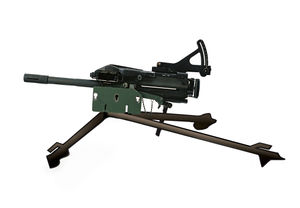Mk 19 grenade launcher
| Mk 19 grenade launcher | |
|---|---|
 Mark 19 on a lightweight XM205 tripod. |
|
| Type | Automatic grenade launcher |
| Place of origin | |
| Service history | |
| Used by | See Users |
| Wars | Vietnam War, 2006 Lebanon War, Gulf War,[1] OIF, OEF |
| Production history | |
| Designer | Naval Ordnance Center - Louisville |
| Designed | 1966 |
| Manufacturer | Saco Defense Industries (now a division of General Dynamics Armament and Technical Products), Combined Service Forces |
| Produced | 1967 - present |
| Variants | Mk 19 Mod 0, Mk 19 Mod 1, Mk 19 Mod 2, Mk 19 Mod 3 |
| Specifications | |
| Weight | 72.5 Pounds (Gun only) |
| Length | 43.1 Inches |
| Barrel length | 16.25 Inches |
| Width | 13.4 Inches |
|
|
|
| Cartridge | 40x53mm |
| Action | Advanced Primer Ignition / Blowback |
| Rate of fire | 325-375 rpm (Cyclic) |
| Effective range | 1500 yards |
| Maximum range | 2,212 yards |
| Feed system | Belt |
The Mk 19 Grenade Launcher is an 40 mm belt-fed automatic grenade launcher or grenade machine gun that entered U.S. military service during the Cold War, first seeing action during the Vietnam War and remaining in service today.
Contents |
Overview
The Mk 19 is a belt fed, blowback operated, air cooled, crew served, fully automatic weapon that is designed not to cook off. It fires 40 mm grenades at a cyclic rate of 325 to 375 rounds per minute, giving a practical rate of fire of 60 rounds per minute (rapid) and 40 rounds per minute (sustained). The weapon operates on the blowback principle, which uses the chamber pressure from each fired round to load and re-cock the weapon. The Mk 19 is able to launch its grenade at a maximum distance of 2,212 meters, though its effective range for a point target is about 1,500 meters, since the large rear leaf sight is only graduated to 1,500 meters. The nearest safe distance to launch the grenade is 310 meters in training and 75 meters in combat. While the Mk 19 has a flash suppressor, it serves to save the eyesight of its operator, and does not conceal the weapon's position. For night operation, an AN/TVS-5 night vision sight can be fitted.
_fire_the_MK-19_40mm_grenade_launcher_during_MIL-EX_2003.jpg)
The Mk 19 is a man-portable crew-served weapon that can fire from a tripod mounted position or from a vehicle mount (this being the preferred method as the weapon alone weighs 72.5 lbs). The primary ammunition for Mk 19 is the high explosive dual-purpose M430 grenade. Upon impact, the grenade can kill anyone within the radius of five meters, and wound them within the radius of 15 meters. It can also punch through two inches of rolled homogeneous armor with a direct hit (0 Degree Obliquity), which means it can penetrate most infantry fighting vehicles and armored personnel carriers. It is especially effective when used against enemy infantry formations. The ammunition comes in 32 or 48 round cans weighing 42 and 60 lb, respectively. Due to its low recoil and comparatively light weight, it has been adapted for use on many different platforms, including small attack boats, fast attack vehicles such as the Humvee (HMMWV), AAV and Stryker, military jeeps and a large variety of naval mounts.
The Mk 19 automatic grenade launcher replaced the earlier Mk 18 hand-cranked multiple grenade launcher. The 40 mm ammunition used (40x53mm) is not interchangeable with that used in the M203 (40x46mm). The M203 ammunition develops a lower chamber pressure, and resultant lower muzzle velocity and range, compared to ammunition loaded for the Mk-19. The Mk 19 fires from an open bolt. The rounds are mechanically fed onto the bolt face with the pull of the charging handles. When the trigger is pressed, the bolt closes, and the firing pin is released. The recoil blows back the bolt, feeds a new round onto the bolt face, which pushes the expended casing off the bolt face.
The Mk 19 is made by Saco Defense Industries (now a division of General Dynamics Armament and Technical Products).
Unlicensed imitations
Up to date 2 countries have tried to reverse engineer the GDATP Mk 19 AGL:
- Korea
- The Mk 19 was reverse engineered and a Korean version developed, but it has failed induction tests in numerous countries. Although it can fire, it has poorer battlefield reliability than the original, and was rejected due to its very short life span.
- Turkey
- Mechanical and Chemical Industry corporation MKEK had taken over the project from Roketsan to reverse engineer the GDATP Mk 19 and have developed a unlicensed local version. Although this is an exact copy of the Mk 19 it has failed induction tests in different armies. It has also been reported that the Turkish version cannot sustain constant exposure to battlefield conditions.
Both the Korean and Turkish Armies are using the original American GDATP developed Mk 19.
Users
GDATP has built nearly 35,000 Mk 19 Mod 3 systems for roughly 30 customers since 1984.[2] Users of the Mk 19 include:

 Australia[3]
Australia[3] Israel:[3] Adopted by the Israeli Defence Forces (under the name "Maklar," for mikla rimonim or "grenade machinegun"), to be fielded in infantry and mechanized units.
Israel:[3] Adopted by the Israeli Defence Forces (under the name "Maklar," for mikla rimonim or "grenade machinegun"), to be fielded in infantry and mechanized units. Lebanon[4]
Lebanon[4] Malaysia[3]
Malaysia[3] Mexico:[3] Used extensively by the army in the Mexican drug war.
Mexico:[3] Used extensively by the army in the Mexican drug war. South Korea: Designated K4.[3]
South Korea: Designated K4.[3] Spain[3]
Spain[3] Sweden: Designated Grsp.[3] Used by Kustjägarna.[5]
Sweden: Designated Grsp.[3] Used by Kustjägarna.[5] Taiwan[1]
Taiwan[1] United States:[3] Used by American forces in Somalia (1993) and in Iraq (1991) by special forces operating behind enemy lines and Military Police. Currently in widespread use in the U.S. Military.
United States:[3] Used by American forces in Somalia (1993) and in Iraq (1991) by special forces operating behind enemy lines and Military Police. Currently in widespread use in the U.S. Military.
See also
- Mk 47 Mod 0 Striker
- HK GMG, similar weapon used by the German Army
- SB LAG 40, similar weapon used by Spain
- ST Kinetics CIS 40 AGL
- Vektor Y3 AGL, similar weapon of South African origin
- AGS-17 ( Automatic Grenade Launcher - 30mm grenade)
- AGS-30 ( Automatic Grenade Launcher - 30mm grenade)
- SAG-30
References
- ↑ 1.0 1.1 "Report: Profiling the Small Arms Industry - World Policy Institute - Research Project". World Policy Institute. November 2000. http://www.worldpolicy.org/projects/arms/reports/smallarms.htm. Retrieved 2010-07-15.
- ↑ http://www.asianmilitaryreview.com/upload/200711272151281.pdf
- ↑ 3.0 3.1 3.2 3.3 3.4 3.5 3.6 3.7 Jones, Richard D. Jane's Infantry Weapons 2009/2010. Jane's Information Group; 35 edition (January 27, 2009). ISBN 978-0710628695.
- ↑ Miles, Donna (April 8, 2009). "Gates, Lebanese Defense Minister Explore Expanding Bilateral Relationship". American Forces Press Service - DefenseLink News. http://www.defenselink.mil/news/newsarticle.aspx?id=53846. Retrieved 2009-04-08.
- ↑ http://www.specialoperations.com/Foreign/Sweden/default.html
External links
- General Dynamics
- MK19 MOD 3 40mm Machine Gun - Global Security
- 40mm grenades - Global Security
- MK19 Review
- M430 40mm Cartridge High-explosive dual purpose (HEDP) round specs
- Martin Electronics, Inc. Home Page - 40 mm Ammunition
- Full Size Accurate replica MK19 for training, and educational, militaria displays
|
|||||||||||||||||||||||||||||||||||||||||||
|
|||||||||||||||||||||||||||||||||||||||||||||||||||||||||||||||
